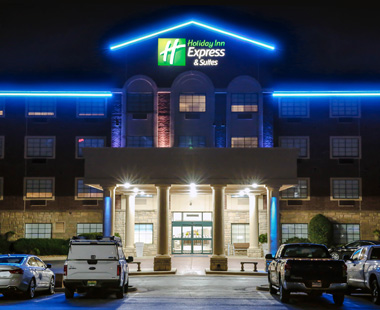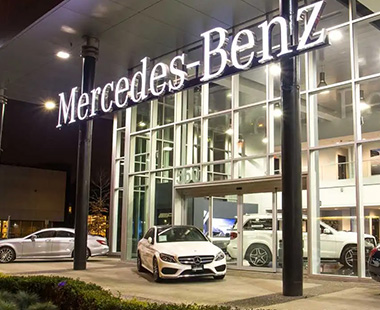

By Adonis Brewer
Manager of Business Development
Here's what we'll cover:
Lighting influences everything; without it, you probably wouldn’t be able to see much of anything. That said, the science of indoor and outdoor LED lighting isn’t just about intensity and brightness – it’s also about quality and, more importantly, color temperature.
Take a moment to look up from your screen for a second. If you’re reading this in the comfort of your home, the lights around you are probably warmer and a little more peaceful, but if you’re in the office, chances are you’re sitting in a room with cool-toned light that heightens your awareness and productivity. Again, lighting influences everything.
This is true from home, to office, to different kinds of commercial establishments. Different styles of lights and their corresponding color temperatures can profoundly influence the way people interact with their surroundings – and that’s why picking the right one can be such a game-changer.
While it may seem kind of arbitrary at first, building a working understanding of color temperature can lead you in the right direction while selecting a lighting plan for your business. Let’s dive in and illuminate all the nitty gritty details of color temperature and why it matters.
What is Color Temperature?
The term “color temperature” can be a little mystifying, but it really is quite intuitive when you get down to it.
Color temperature, or Correlated Color Temperature (CCT), has a formal definition of “the appearance or perceived color of the light generated by a specific source,” but all it really refers to is the “warmth” or “coolness” of a specific lighting fixture.
A light’s coolness or warmth is expressed in Kelvins (K) using a 4 to 5-digit number, with lower values corresponding to warmer tones while higher numbers materialize in cool, white lights. A good way to think about it is as the opposite of how traditional temperature systems function.
With this in mind, a single LED lighting fixture can be tuned to replicate everything from the soft glow of candlelight all the way to an incredibly sunny day in the middle of summer – as well as all the classifications in between.
Here are some of the most commonly used color temperature ranges and their corresponding CCT labels, according to how they would appear in day-to-day life:

- 1800K CCT - Candlelight
- 2800K CCT - Extra Warm White
- 3000K CCT - Warm White
- 4000K CCT - Cool White
- 5000K CCT - Daylight
- 6500K-7500K CCT - Overcast
- 8000K-12000K CCT - Blue Sky
Understanding Warm vs. Cool Colors
Now that we’ve established a rudimentary understanding of what color temperature is and how warmth/coolness of light is measured in Kelvins, a new question is likely to emerge in your mind: why exactly does this matter?
Luckily, you won’t have to rely on intuition alone. A wealth of scientific research explores the differences between warm and cool colors and how they encourage different kinds of behavior.
Let’s start with warm color temperatures ranging between 1800K-2800K. Lights within this range are usually expressed in calming warm tones akin to the gentle embers of flame or an orange sunset. When used in LED lighting, this can create a warm and inviting atmosphere that supports social interaction and relaxation.
On the other side of the spectrum are the cooler tones in the range of 5000K to over 8000K. As the name suggests, lights on this side of the color temperature spectrum are usually closer to pure white but can also veer into blue-tinged icy lighting. This is ideal for environments that encourage focus, alertness, and productivity.
Between the two bookends of cold and warm color temperatures is everything considered to be “neutral” at 3000K-4000K, with some options leaning one way or the other. This option is usually quite versatile, but can be a bit lacking when you have a specific atmosphere you want to set.

LumiFlex™: Durable, flexible, and
the perfect neon replacement
- Long Life: 50,000+ hrs
- IP68, UV resistant
- Perfect for signs, decoration, and track lighting
Understanding Different Color Temperature Applications
As we mentioned earlier, various color temperatures can be utilized to create a plethora of different atmospheres and feels – with some ranges more suitable than others.
While there are no strict rules about what you can and can’t do with your LED lighting fixtures, there are some guiding principles employed across industries and use cases that may be able to help you achieve the look and feel you desire.
Let’s start with warm color temperatures. Earlier, we talked a little about how warm lights are conducive to social functions and relaxation, and this scientifically-backed fact can be especially advantageous if you run a business built on pleasure and enjoyment, like in hospitality or the F&B industry. You want customers to associate your brand or establishment with a good time, and this can be an excellent way to unlock those feelings.
Neutral light, on the other hand, may not have as much character as its warmer counterparts, but it serves a very specific function that many folks are familiar with: simply getting the job done – literally. Neutral lights are a mainstay in office settings because they provide the right amount of illumination without the sleepiness of warm light or the sometimes sterile nature of ultra-cool options.
Now we get into cool lighting – often associated with commercial establishments, shopfronts, general retail stores, hospitals, and anywhere where things need to stay moving. This is because bright, clear, cool lights serve a twofold purpose: they illuminate important things (like products or equipment) while also providing enough visibility for the folks who keep things running.
With all of this said, however, it’s important to recognize that most businesses are actually quite complex and require many different moving parts to function at maximum efficiency. As such, combining and mixing different color temperatures may actually make for the best overall experience, and working with seasoned professionals (like us), can help you masterfully strike that balance.
Color Temperature’s Impact on Mood and Perception
Color temperature doesn’t just permeate into how a place looks; it also has a sway over how it feels to customers and clients. A good way of visualizing this impact is with one of the world’s most popular pastimes: movies.
When filmmakers want to evoke the atmosphere of heat or intense emotional moments, they may layer a warm filter over their footage to achieve their goals. Likewise, cooler color treatments can make a viewer physically feel the chills of the portrayed scene while actually sitting in a comfortable heated cinema chair.
Color temperature in real-life use cases achieves much of the same outcome – although it’s usually a mix of light-related factors that impact people's overall perception and experience.
Generally speaking, lower brightness levels (to a point) and warmer color temperatures can induce pleasant feelings and even enhance creativity when employed in specific situations. Individuals may also find spaces awash in warm light to be more welcoming and inviting – allowing them to relax more.
Cool color temperatures, on the other hand, are all about clarity and consciousness and the promotion of productivity and industriousness. To put things plainly, establishments illuminated in cool color temperatures tend to be perceived as a clean environment conducive to work, meeting goals, and getting things done, often making people feel more alert.
One of the reasons often suggested in academic literature is how different color temperatures stimulate a person’s circadian rhythm (or internal clock) in various ways. Specifically, much of the research seems to posit this: cooler color temps simulate the sun on a clear day, making individuals feel more ready to take on active work.
Similarly, warmer ranges of color temperatures are closer to sunsets, evoking sundown after a day of frenetic work when folks can finally sit back and wind down for the night – hence the feelings of relaxation.

Leon: Our go-anywhere,
do-anything rigid LED
- Long life: 50k-70k hours
- 85% more energy efficient than neon
- Seamless color, no sags, no light gaps
How Does Color Temperature Affect Customer Behavior and Sales?
One of the lesser-acknowledged, yet equally impactful outcomes of choosing a suitable lighting system for your establishment is that feeling of brand consistency. But what does that mean? Let's dive in a little deeper.
When you design your interior lights to match your brand’s overall vibe, you create a feeling of consistency and reliability that appeals to consumers who want quality service every single time they visit – and who doesn’t want that from a service provider?
This becomes doubly true when you establish multiple locations of the same store or run a restaurant that's part of a much larger chain. In this case, your customers likely already have expectations of what they will experience, and maintaining the same feeling throughout different stores can make them feel comfortable faster – and, therefore, more likely to spend time and money.
This leads us to the main point of consideration: influencing customer behavior. We've waxed on about how color temperature can impact how your business is perceived, but it really is about creating an experience for clients and customers. In short, you’d want to pick a lighting combination that leads people to spend more money at your establishment.
By selecting a color temperature profile that suits your business’ specific needs, you provide a well-lit path for customers to follow as they navigate everything you have to offer – therefore improving overall sales.
Let The Professionals Light The Way
Light impacts all facets of our lives, and so they influence the businesses we run, too. Optimizing your establishment’s lighting design can be a boon upon your business’ bottom line, but finding the perfect formulation can be quite stressful when you have other things to worry about.
That’s where we come in. With decades of experience with commercial lighting, we have the experience and know-how to fit your space with whatever you need – and even make a recommendation or two along the way to get the most out of your dollar.
We can help increase your brand’s visibility and build a shining first impression to attract – and keep – customers for life. Send us a message so we can find the perfect lighting solution for you.
We’ve been helping businesses of all sizes find the lighting solutions that would benefit them the most. Let’s get started together.
Talk with our Sales Team
About Adonis Brewer
Adonis Brewer, Manager of Business Development at Lektron Branding Solutions, connects businesses of all sizes throughout North America reach more customers through turnkey LED, product identification, and signage solutions that attract more customers and increase revenue.



